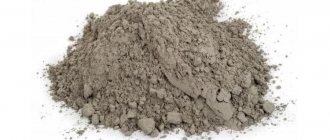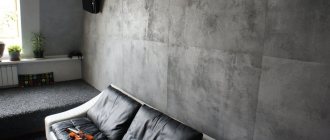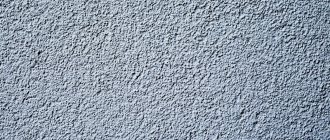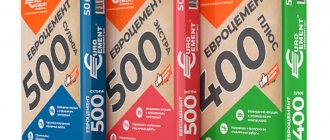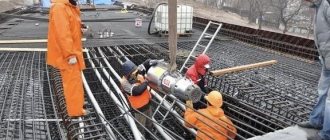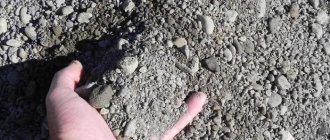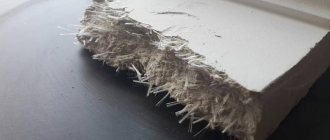Concrete and reinforced concrete structures are strong and durable, but under the influence of atmospheric factors they begin to collapse. The reasons for the decrease in strength are temperature changes, high humidity, sunlight, etc. Adding sulfate-resistant cement to concrete helps increase the service life of the structure.
This type of cement helps to increase service life.
Varieties
Building mixtures that are resistant to aggressive factors are divided into the following types:
- cement reinforced with mineral additives;
- pozzolanic binder hydraulic composition;
- sulfate-resistant Portland cement;
- Portland slag cement.
Portland cement increases the resistance of concrete mixtures to temperature changes and reduces the aggressiveness of sulfates if these substances are contained in large quantities in the material.
Explanation of markings
Construction cements have their own markings, approved and described in SNILS and GOSTs. The material can also be manufactured according to other regulatory documents. If you saw PC among the first letter designations, then this is Portland cement. Portland slag cement is abbreviated as ShPTs. You can understand that this is sulfate-resistant Portland cement by the letters SPTs or SSPTs.
When mineral additives are present in the material, the letter D is added to the abbreviation, then the marking looks like this: SPCD. Sulfate-resistant Portland slag cement is designated SSSHPTs. If you have pozzolanic and tensile cements in front of you, you will see the following letters: PPC and NC, respectively. White Portland cement and waterproof expansive cement are designated by the letters PCB and VRC.
Cement marking and interpretation is important for the consumer. This way he will be able to purchase the goods he needs. After the first letters there will be numbers indicated, which in the markings look like this: PC-500. This indicates that this is grade 500 cement. The markings may be followed by other numbers and letters. For example, if cement has a maximum content of additives, then you will see: D0, D5, D20. This corresponds to a percentage of 0.5 or 20%.
Rapid-hardening cement is designated by the letter B. Plasticizing cement is PL, hydrophobized cement is GF. Material with a standardized clinker composition - N. At the end of the marking a regulatory document is indicated. These may be technical specifications or state standards on the basis of which the material is manufactured.
Methods of obtaining
Concrete having the desired characteristics is obtained in 2 ways:
- Production of mortar with subsequent introduction of mineral additives.
If the volume of added substances exceeds the norm, the strength of the concrete structure decreases. Increased fragility causes the collapse of the structure. When preparing such solutions, one must not deviate from the recommendations contained in regulations.
- Addition of sulfate-resistant Portland cement.
The introduction of this component increases strength, protecting the structure throughout its entire service life. The sulfate-resistant solution acquires the desired qualities after 28 days. Portland cement contains 20% slag. When producing slag Portland cement, this component can be replaced with ash, the amount of which in the volume of the solution should not exceed 10%.
Technical indicators
According to GOST 31108–2003, pozzolanic Portland cement has the following characteristics shown in the table:
| № | Name of properties | Quantity | Note |
| 1 | Active additives (%) | 20–40 | |
| 2 | Density (g/cm³) | 2,7–2,9 | |
| 3 | Shelf life (month) | 6 | In a dry place |
| 4 | Compressive Strength(MPa) | 42,5–62,5 | After 28 days |
| 5 | Setting time start/end (hour:min) | 0:45/12:00 | |
| 6 | Flexural strength (MPa) | 6,8 | After 28 days |
| 7 | Density of cement paste (%) | 28–35 | |
| 8 | Volumetric weight (kg/m³) | 800–1000 | In a loose state |
| 9 | Specific gravity (kgf/m³) | 2,7–2,9 | |
| 10 | Volumetric weight (kg/m³) | 1200–1600 | In compacted form |
| 11 | Grinding fineness on sieve No. 008 (%) | To 10 |
Types of cements
In the manufacture of sulfate-resistant concrete, the following types of cement are used:
- Plain Portland cement.
The introduction of ballast and mineral additives into such material is prohibited. Cement is universal, frost-resistant and insensitive to high humidity.
- Portland cement containing mineral additives.
The latter are used as slag, microsilica or pozzolan. The mixture should contain no more than 10% mineral component. The material can withstand a large number of freezing cycles and does not collapse under the influence of moisture.
- Portland slag cement.
The composition is based on pressed blast furnace slag, which is mixed with clinker in a 1:1 ratio. This component makes up 40-60% of the total amount of concrete. The slag must contain an appropriate amount of aluminum oxide. The disadvantage of this building material is its sensitivity to temperature changes.
- Pozzolanic cement.
The composition includes pozzolans and furnace slag. The former are minerals emitted by volcanoes. Unlike previous types, this material is more resistant to sulfates, but is sensitive to sudden changes in temperature and humidity.
Sulfate-resistant concrete
- Mixture requirements
- Production of the composition
Concrete and reinforced concrete are actively used in construction. These are strong, reliable, durable materials. However, they are not without drawbacks. In particular, the underground part of structures is exposed to groundwater and moisture. And water, as you know, contains many sulfates, salts and their compounds that can damage the integrity of the structure. Therefore, it is quite logical and even necessary to provide protection against such corrosion.
The sulfate-resistant composition will increase the durability of the foundation and the rate of its destruction by groundwater.
The optimal option for protection against sulfate corrosion under conditions of regular water saturation is sulfate-resistant concrete.
This is the only composition that can provide reliable protection of the structure from corrosion by sulfate-containing mixtures.
Using sulfate-resistant concrete increases the reliability of the building.
There are 2 main ways to obtain sulfate-resistant concrete: using regular cement with special modifying additives or using sulfate-resistant cement. The second method is much more preferable and reliable, because it provides protection at all stages of the life of the structure. Concrete based on ordinary cement with additives will also protect products, but such protection is comparable to treating shoes with a water-repellent compound. And sulfate-resistant cement is, by analogy, rubber boots. The difference is significant. Such cements are usually divided into types:
- sulfate-resistant Portland slag cement;
- sulfate-resistant Portland cement;
- pozzolanic Portland cement;
- sulfate-resistant Portland cement with mineral additives.
In addition, there is a gradation of compressive strength at 28 days. Depending on the indicators, the brands M300, M400 and M500 are distinguished. GOST 22266-94 regulates the content of components of the sulfate-resistant composition. For example, in Portland cement with mineral additives, no more than 20% of the mixture of pozzolana and slag is allowed; for slag Portland cement, it is possible to replace slag with ash (acidic) or pozzolana in an amount of no more than 10% of the mass of the composition. In sulfate-resistant Portland cement, the content of sulfuric acid anhydride cannot exceed 3-4%. An increased content of substances that react with sulfates contained in water is fraught with fragility of the structure and its internal destruction. A correctly selected proportion will ensure not only the stability of the composition, but also compaction. Therefore, sulfate-resistant cement must comply with GOST requirements.
Properties
The main properties of sulfate-resistant building mixtures include:
- Fast hardening.
The solution sets in 1-10 hours.
- Water consumption.
This indicator helps to properly dilute the dry mixture with water to obtain a solution of the desired viscosity. For sulfate-resistant cement this parameter is 22-28%.
- Fraction size.
The volume of particles remaining after sifting through a sieve with 80 micron cells should not exceed 15%.
Portland cement M500 D0.
How is sulfate resistance determined?
- Fill 15 molds 25x25x254 mm with cement-sand mortar.
- After 24 hours, samples are removed and placed in water for 27 days.
- After keeping in water, 12 samples are taken and 6 are again placed in water, and the remaining 6 are placed in a 5% sodium sulfate solution.
- They remain in this position for up to 12 months, with control samples in permanent distilled water, and test samples in a solution that is periodically changed to fresh.
- They are periodically removed and inspected, recording defects - chips, cracks, bends of the samples.
All results are processed using complex formulas and finally summarized in a table:
But in this table everything is only about cements. So, the sulfate resistance of concrete is determined in each specific case depending on the aggressiveness of the environment in which it will be located, i.e., specific indicators of the content of SO42- ions in water. Design requirements for water resistance, which have classes W 4 – W20. Based on these data, the grade of cement is selected according to a number of tables in the Code of Rules 28.13330. 2012 (Protection of building structures from corrosion), which can be used to prepare a concrete mixture in a particular project. As you understand, the sulfate resistance of concrete is a very complex topic and cannot be dealt with simply.
Colored and white Portland cement
Along with protection from aggressive factors, cement must have good aesthetic qualities.
There are 2 types of mixtures:
- White Portland cement.
It is produced using the same technology as simple cement. The difference is the white clinker content. An important indicator is the type of clay used. It should contain a small amount of metal oxides that impart yellowness. Whiteness is achieved by converting iron carbide into oxide.
- Color.
It is made on the basis of white cement by adding dyes. The latter are hematite ore, phthalocyanine pigments, iron oxide, and soot.
Material manufacturers
Pozzolanic cement is produced by a small number of companies because its production requires special equipment and access to special components. The most famous manufacturing companies are:
- "Kavkazcement";
- "Novoroscement"
- "Belarusian Cement;
- "Verkhnebakansky cement plant".
The cost of a standard bag of cement (40 kg) is 500-600 rubles. Purchasing material abroad will be economically unprofitable, as it will lead to a significant increase in price. Pozzolanic cement is a high-quality, durable and reliable material, the unique properties of which are fully manifested only with strict adherence to technology, so before purchasing it is important to familiarize yourself with the rules of operation and the nuances of its use.
Application area
The scope of use is determined by the advantages of cement.
Another brand of sulfate-resistant cement.
Mixtures are used for the construction of facilities exposed to negative environmental factors:
- frosts or sudden increases in temperature;
- regular precipitation, increased humidity, tidal and groundwater;
- swelling or shrinkage of soil;
- exposure to aggressive substances contained in wastewater;
- earthquakes.
Sulfate-resistant concrete is used for the construction of foundations, hydraulic structures, bridge piles, reinforced concrete casing structures for wells, river and sea jetties.

